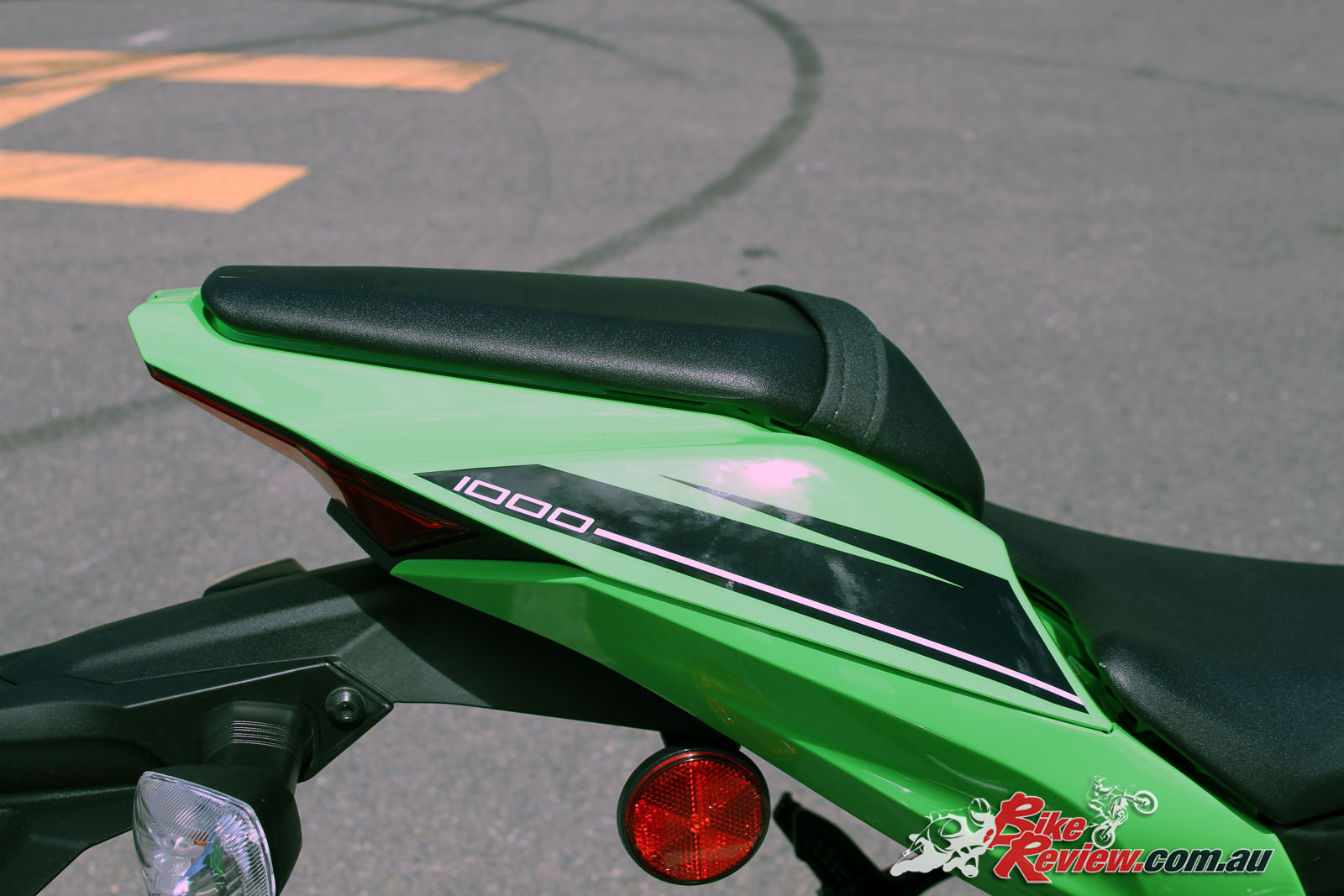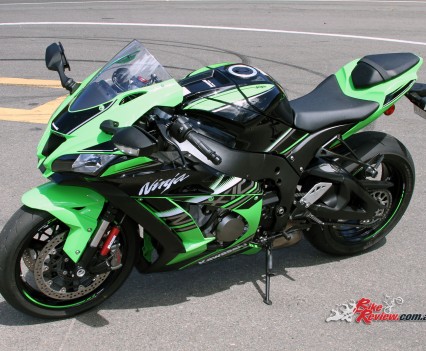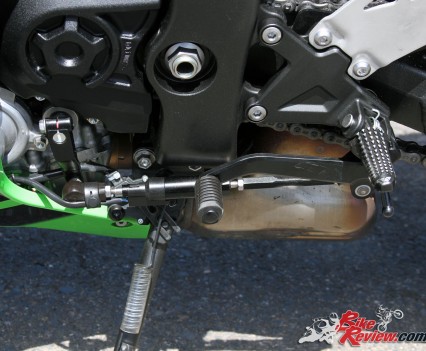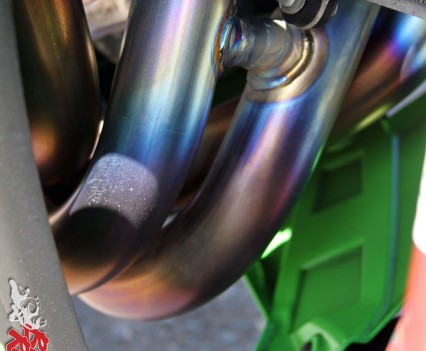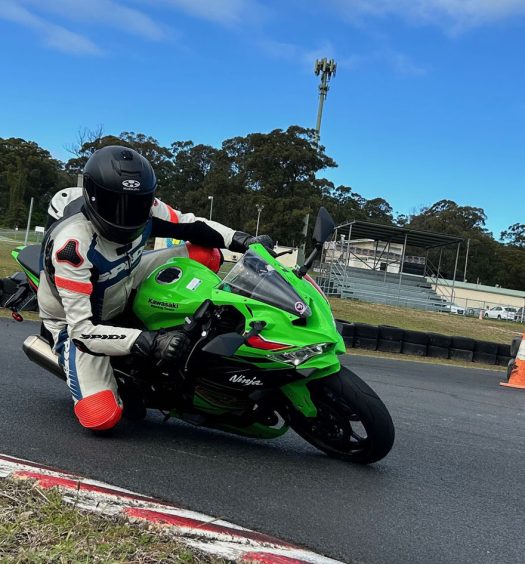Review: 2016 Kawasaki Ninja ZX-10R Road Test
We hit the real Australian roads on the new Kawasaki ZX-10R Ninja. Here's our 2016 Kawasaki ZX-10R Ninja review. Test by Kris Hodgson, Jeff Ware, Photography by Heather Ware, Kris Hodgson
I first tested the new ZX-10R late last year at Wakefield and was suitably impressed. You can read our full report here, we were among the very first in the world to ride the bike, two months ahead of the World Press Launch.
What sticks in my mind is Project Leader Yoshimoto Matsuda explaining to the gathered journalists that this was a race bike, designed for the track, followed by the clarification that this kind of focus should lead to a great road bike.
At Wakefield’s often tight and twisty curves there was plenty of hints that this would be true, but it wasn’t till just this week that I finally had the opportunity to really put the 2016 ZX-10R to the test on our Aussie roads.
Jumping on board the bike is as diminutive as I remember and a direct contradiction to taking a walk around the bike. The front fairing is wide with a revised design from the previous model, including special ducts to prevent negative pressure behind the screen. This is further emphasised by the mirrors with integrated indicators and wide tank, with only the rear of the bike tapering away to a shapely tail.
The ‘bars are wide and racey, while vision through the mirrors is exceptional at low speeds but quickly deteriorates when the revs rise – you can tell someone is there, but not who or what. You don’t feel the vibrations but the mirrors let you know they are there.
Where on the track the high ‘pegs seem natural during your shorter ride sessions and cornering, on the road they are a just a little cramped after the first hour in the saddle for my 180cm height, although I’m on the longer legged side of the scale, I’d drop them 5 -10mm. As mentioned the ‘bars are wide and an easy reach, which allows for a relatively upright and comfortable position. I noticed a little strain on my wrists on longer rides but a good three-hour loop with a single quick stop for petrol left me mainly wishing for a softer seat, with no neck or back strain.
Controls and electronics are numerous; Engine Braking Control (KEBC), cornering ABS and a revised Traction Control system (S-KTRC) – thanks to a Bosch IMU and fully electronic throttle, Quick Shifter (KQS) and Launch Control (KLCM) all making up the technological package. The indicator control was also quite stiff, easily flicking on with a press to left or right, but slightly recalcitrant when it came to cancelling the indicator after a corner.
The electronics are controllable through the left switchblock, but some, like the KEBC require the bike to be stationary.

The Showa Balance Free Forks are something off this planet and seriously high end kit for a Japanese sportsbike.
Starting the bike up, the revs tic along between 1-2000rpm but once warm the revs retreat to 1000rpm, which feels a little on the slow side, especially on the first take-off or two, where I hadn’t got used to the natural take-up point for the throttle.
Once I got used to the throttle, which is quite sensitive, take-off is exceptionally smooth as long as you roll on with confidence and use a lot of revs. If you try and take it too easy the bike will stall just off the mark.
Power below 4000rpm remains gentle with nice linear delivery that actually makes the ZX-10R an exceptionally forgiving road bike in all those conditions that cause headaches on many other all-out sportsbikes. I can see it being exceptional even without the traction control in the wet. In slow traffic it’s also not a hard motorcycle to plod along on, and doing a U-turn is about as easy as it gets on a bike with clip-ons.
For a regular daily rider like myself in normal traffic conditions it’s very friendly and you wouldn’t know you’re on a 200hp superbike. There is noticeable heat once you’ve been riding a while, mainly at the ankles, however this is not unbearable.
Rolling past bottom end the intake growl starts and the acceleration really develops and it’s easy to reach 100km/h in first before even thinking about second gear, such is the deceptiveness of the power delivery. You know you’re moving and that the bike’s fast but in typical superbike manner this is a machine you could get into serious trouble with the law on if you’re not paying close attention to the speedo!
It’s not just that the bike is fast, all the superbikes these days are, it’s the fact it’s so hard to tell that you’re going quite that fast, especially through the twisties where you can power along at a very quick pace effortlessly.

The clutch has a light action and gear shifts are clunky but firm, when downshifting, and the engine pulls strong from right down low
Riding below 100km/h you’d be hard pressed to need anything more than third gear, with quite tall gearing still offering good pull from almost anywhere in the rev range from 5000rpm north. Above 6000rpm you get swift acceleration. There’s no hint of lugging the engine once revving either, even a few times when I was a couple of gears higher than was really necessary and just cruising along. It doesn’t have the bottom end of the other superbike class machines but it makes up for it up top and means it is a nicer ride at legal speeds.
Power above 10,000rpm is staggering, however, on the road unless I was going to try running around in first gear there just wasn’t the opportunity to really test this part of the rev range much without entering bike confiscation and straight to jail territory.
Further reinforcing my experience at Wakefield Park the ZX-10R is exceptionally nimble and while handling isn’t what I would call telepathic – with the bike going where you want almost before you think about it – it is incredibly sharp and very controllable, a huge improvement on the previous model.
Your input and concentration is necessary but the ZX-10R rewards that with some breathtaking cornering, with a sense of stability that I can’t recall having experienced before to such an extent. The Bridgestone RS10 tyres certainly help, offering great grip in these dry conditions, but the feeling of being on rails is just amazing.
This is no doubt thanks to revised chassis geometry, the longer swingarm and revised weight balance and centre of gravity, not to mention lighter crankshaft, which make the new generation of ZX-10R a much more balanced machine.
The new Showa Balance Free Forks in particular offer a new level of front end feel and support and I found the front end faultless for my 65-70kg riding weight (depending on gear), even when hard on the brakes, with minimal dive and amazing tracking.
The Showa shock on the other hand was too stiff for my weight and pace, meaning I was kicked out of the seat over larger road irregularities on occasion and over extended poor surfaces would find the rear stuttering. Jeff is heavier and found it spot on. A few mm less preload and high and low speed comp reduces is all that it would take to fix that for me.
What this did help demonstrate was just how well sorted the front end was. The vast majority of the roads I traversed while testing out the ZX-10R were well surfaced and even with the rear shock creating a sometimes painful experience, the road holding and feel remained exceptional.
It’s quite an evolution from the last generation of ZX-10R too, which was one of my favourite superbikes, but which the new ZX-10R has surpassed in every way.
Other points of note included the Brembo brake package, with M50 calipers and matching master-cylinder providing good modulation and stopping power but without a heap of initial bite, which I’ll put down to the bike being through a number of journalists for testing prior to our receiving the bike as at the track they were strong on initial bite.
The rear brake I mainly used lightly for U-turns, as it wasn’t necessary for rear stability through corners and wasn’t really offering much power. Stopped at lights at even a slight incline I had to put an overly large amount of pressure on the rear brake to prevent the bike rolling, which is no doubt an issue with the pads again, with the rear brake being far more effective at the earlier track test.
This test bike was equipped with Kawasaki’s brilliant new ABS system, which includes cornering ABS, designed to help balance braking power while leaning the bike over, offering additional safety for hairy conditions and preventing the bike from standing up and altering your line. For this test with extremely hot and dry conditions I couldn’t really say I noticed the cornering ABS at all, nor did I see it activate during any of the testing. I’m pretty sure Jeff did though! His test is below.
I can see the logic and usefulness as a safety and riding aide in unpredictable road conditions, where you can find anything around a tight corner and don’t want to end up off the road if that does happen.

I could still feel the generational similarity with the ZX-10R engine to an extent, but the bike itself is majorly transformed from the previous model, with the improvements on every front making it my pick of the latest superbikes available, that I’ve tested so far.
With the Kawasaki Traction Control I ended up leaving it on level 1 – which is actually one of the levels recommended for the track, with conditions remaining really good through the week we had the bike.
I can imagine knocking it up a few levels with sketchy or colder conditions but the bike is so predictable and stable, with such great feel, that I didn’t ever feel the need to rely on the Traction Control except as an emergency safety feature, especially with the RS10 tyres offering great grip in the dry.
At 206kg wet weight fully fueled the ZX-10R carries the weight well, from pushing it around the garage, through to riding at both low and higher speeds, where changes of direction or changing your line mid-corner are effortless, requiring only small inputs. The Ohlins electronic steering damper also ensures it stays inline when hard on the gas, particularly at the track and is mounted atop the triple clamp, fully visible, as a great piece of bling.
I settled on running KEBC to off, which takes advantage of the standard back-torque limiting clutch, along with full power mode, with the four’s engine braking not needing to be reduced by the KEBC. Kawasaki does also offer a USB dongle that can be used to deactivate the ABS for those that way inclined, or thinking about heavy track use, but still wanting the ABS for the road.
I have to admit that Kawasaki’s 2016 Ninja ZX-10R really impressed me. I’m any everyday rider and use my bike for everything as I don’t have a car, with the ZX-10R actually striking me as a bike that’s capable of doing far more than quick lap times and doing it very well.
Comfort and rideability are both exceptional, as mentioned I’d probably lower the ‘pegs a little, but this is an easy mod. The seating position wasn’t a strain or overly aggressive, with the front suspension and overall handling managing to do everything I could want and more.
The fact I could as happily ride the bike through the usual horrendous Sydney traffic as I could go for a fang through the local twisties is also a huge selling point.
Not only is the engine a belter, with a nice controllable bottom end, that develops into a blistering mid-range (and top end, if you can find somewhere to appreciate it – like the track), but the handling is just sublime. This machine gave me absolute confidence every second I was riding it.
Definitely organise a test ride if you’re even the slightest bit interested.
Jeff’S 2016 Kawasaki ZX-10R Road Test Second Opinion
The new Ninja ZX-10R impressed me no end when I rode it at Wakefield Park back in November. Since that time I have been eager to try the bike in the real world as I could tell by the way it soaked up the bumps and steered at Wakefield Park that it was going to be a good handling, confidence inspiring road sportsbike. Although the bike is designed for the track, the majority of owners will do most of their riding on the street with the odd track day thrown in to blow out the cobwebs.
It is not often that a pure sportsbike, particularly a litre-class bike with such high specification, comes along that is a machine a daily rider could live with. However, amazingly, Kawasaki has managed to pull it off with the ZX-10R, without even developing the bike on the road – at all!
The ingredients to any good motorcycle are confidence-inspiring geometry, a good feeling front end, smooth power delivery and a feeling of grip. With those things right the bike will always be good. A motorcycle doesn’t know where it is – so you can really never believe the saying that a good track bike will sometimes be no good on the street.
A bike is either right or wrong – as I said, it has no idea if it is on a bumpy racetrack or a bumpy road. Suspension settings are all that should separate the two. With that in mind, as I set off on my test loop on the 10R, I knew I would like the chassis before I even turned a wheel.
The engine is a cracker but is quite peaky and there is a lot of electronic control down low to ensure smooth tractable power delivery. This is fantastic for fast lap times because as a rider it is possible to get on the throttle very, very early and wide open while maintaining forward momentum and limiting wheelspin. As I mentioned in my launch report, I felt like I was getting nowhere on track until I saw my lap times. That is the sign of a good engine – one that makes you feel like you are doing it easy…
On the street, however, litre-class sportsbike riders are used to more low down punch than the 10R offers. It did not bother me, in fact, I preferred it in most situations of urban riding, where the 10R is exceptionally good for a sportsbike, and was only caught out occasionally when going for gaps in traffic, when I’d open the throttle below 4000rpm.
The 10R is very similar down low to a 600 supersport bike, so keep that in mind around town and keep the revs up, getting that clutch working off the line. Once in the mountains, though, I really found the soft power delivery and progression from bottom end to mid range to be an advantage and allow for really smooth fast exits. Swings and roundabouts.
You can’t have a stonking top end hit of power and keep your bottom end, unfortunately, physics is the limiting factor there and I know what I prefer on a superbike – 200hp! Those of you who like instant throttle response and grunt will not enjoy the engine as much as riders that enjoy rolling speed and higher rpm acceleration. Remember, this is a bike all about lap times…

The front-end feel and fork action is the best in class. The new 10R gives fantastic rider confidence and front-end stability, while maintaining nimble and accurate steering.
From 5000rpm though, things change, and as the revs build beyond 6000rpm the new Ninja comes alive with smooth, controllable yet seemingly unlimited power on tap. It just goes and goes and goes forever and is the smoothest inline four superbike engine on our streets right now.
The gearbox is faultless and the ratios are well suited, although I would lower overall gearing a few teeth on the rear. There are no EFI glitches at all in the fuelling and with TC on 1 most of the time and the bike in full power mode I was in heaven. A real advantage of this engine is it is not tiring in delivery, meaning 20-minutes into a hardcore ride you don’t start feeling fatigued – it feels like you could ride all day as that hard hitting edge is gone and the delivery is super strong but extremely smooth and subtle.
Once in the mid-range and top end I found the throttle to back wheel connection to be fantastic on the road, where varying conditions mean a good throttle feeling is very important – and aside from purposely testing the S-KTRAC on the wet, dark and mossy sections of my local road, along with the ABS, I did not get either working even when pushing very hard in dry conditions, however, it is nice to know it is there and during my braking tests, where I purposely engaged ABS, straight line and cornering, the system was faultless and kept me upright.
What stood out the most to me on my local roads was the Showa suspension package. I can honestly say that the forks are the best I have ever felt on the road. In fact, I began to think the road might have been resurfaced. The forks are soft enough to soak up almost any bumps, without altering steering, front ride height or stability.
As a rider, you literally can’t tell the forks are traveling up and down their stroke over the bumps, yet when you brake hard or arrive on smooth surfaces with more grip, the damping support is retained for you and there is no excessive or abrupt dive. The rear is the same and I cannot fault the suspension in any way – I would buy this bike just for that alone!
Having done many laps on track, I can also confirm that a good track day set up is only a few minutes and a few clicks away.

The cornering ABS is a great feature to have. I tried it under test conditions and was impressed. It could save your skin one day.
The braking package is also a stand out, with the highest spec M50 Brembo’s and intimate feel at the lever when modulating brake power. As Kris mentioned, initial bite was a little dull on our press bike; however, this was not the case on the previous example I rode. The rear brake on our press bike was also glazed up so lacked power and feel.
The Bridgestone hoops complement the bike and it was good to experience the 10R on these, as well as the Pirelli’s fitted at the launch. I am interested in testing the bike on a set of more road oriented sports tyres to feel how the suspension and geometry is.

The Kawasaki Quick Shifter as standard does a great job. With the race ECU it can also be used for downshifting, while footpegs could be moved down for more road orientated riding for better comfort
Comfort? For a sportsbike it is up there, however, the seat to footpeg distance has been reduced by 10mm due to the sub-frame being lowered, which caused me cramping and pain. I would drop the ‘pegs 5-10mm. This would not compromise ground clearance to any real extent.
The finish of the bike, the quality of the components, the power and the handling all make the new ZX-10R an amazing motorcycle and truly the best Ninja yet. Sure, the dash is the same old one and styling is not completely revised, but the money was spent where it counts – on the engine and chassis, meaning this bike has taken the Japanese litre-class up yet another level just when we all thought things could not get much better.
For our previous full track test, check out: 2016 KAWASAKI NINJA ZX-10R TRACK TEST

The electronics package is greatly updated from the previous ZX-10R model, with a Bosch IMU joining the traction control and helping with cornering ABS. Launch Control is also standard.
2016 Kawasaki ZX-10R Electronics
The electronics on the 2016 Kawasaki ZX-10R have been heavily updated, including a new fully electronic throttle actuation system, with an updated five-mode Kawasaki traction control system, and launch control (KLCM) and engine brake control (KEBC) added.
The S-KTRC system is a hybrid predictive/feedback-type system, which uses Kawasaki’s proprietary dynamic modelling software, and the latest generation Bosch IMU (Inertial Measurement Unit) to provide five measured parameters and a sixth calculated by the ECU, every 5ms.
The Kawasaki Launch Control Mode (KLCM) offers three levels of adjustment allowing riders to take off with full throttle.
The Kawasaki Engine Brake Control can also be activated and allows engine braking to be reduced from that normally offered by the back-torque limiting clutch.
The Kawasaki Intelligent anti-lock Brake System (KIBS) uses wheel sensors and communicates with the ECU – to allow optimal control and minimise intrusiveness. Front caliper hydraulic pressure is also monitored, with smaller regulation increments than a traditional system.
The KIBS system further communicates with the Bosch IMU, allowing a new cornering management function on the ABS equipped models, minimising the effect of braking on standing the bike up mid-corner. Other standard features include the Kawasaki Quick Shifter (KQS), allowing seamless upshifts, and three power modes.

The 2016 ZX-10R boasts all new Showa suspension, including the Balance Free Forks and a full Brembo brake system with M50 calipers.
2016 Kawasaki ZX-10R Chassis
A number of changes to the chassis and the lighter crankshaft deliver a much lighter-handling machine on the 2016 ZX-10R. The big improvement being corner entry and fast change of direction, or flickability.
The twin-spar aluminium frame traces a direct line from the steering head to the swingarm pivot, delivering linear behaviour, or greater control.
The head pipe is moved 7.5mm closer to the rider to place more weight on the front, giving more front-end feel and increased stability and confidence on corner entry, also helping with direction changes and braking.
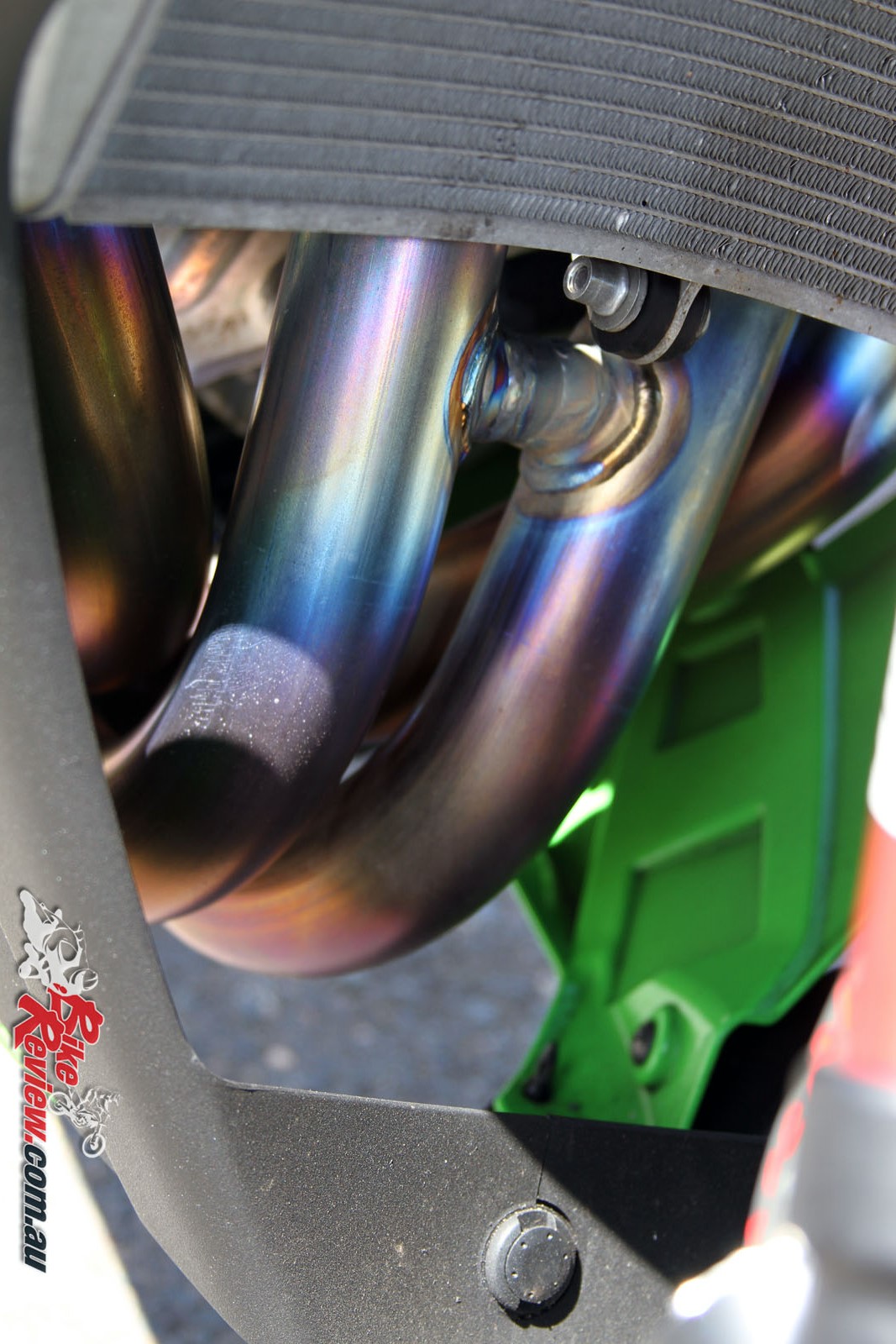
The headers and entire exhaust system including the muffler are all titanium, helping reduce weight and increase longevity.
The swingarm’s optimised torsional rigidity contributes to the bike’s nimbler handling and is 15.8mm longer, contributing to the increased front weight bias and increasing traction on corner exit.
The 43mm Balance Free Forks bring SBK technology to the streets. Showa and Kawasaki developed the race-spec mass-produced suspension system using their data from the Kawasaki SBK effort, offering benefits such as increased comfort, braking stability, front-end feel and independently adjustable compression and rebound circuits.
The Showa Balance Free Rear Cushion shock is a lighter and more compact version of the previous unit. Like the forks, the damping force is generated in an external chamber and compression and rebound are independent circuits. The position of the shock also minimises heat transfer, giving more stable damping.
The brake system is all-new Brembo M50 monoblock radial-mount front calipers, with 330mm Brembo semi-floating rotors and a Brembo master-cylinder. Stainless-steel lines complete the braking system.
2016 Kawasaki ZX-10R Engine
The new engine retains the 2011’s character but offers a stronger mid-range and is more responsive, thanks to a lower moment of inertia.
The intake ports are machined in two stages and the ports allow a greater volume on fuel-air mixture, increasing power, and are polished.
The exhaust ports are also straighter and wider as well as polished, while the combustion chamber is reshaped and has larger 25.5mm EX valves up from 24.5mm. IN valve remains unchanged. Both IN and EX valves are now Titanium.
Larger coolant passages in the head were made possible by the use of long reach spark plugs with platinum tips, contributing to linear power deliver particularly on initial throttle opening.
Revised camshaft profiles give greater overlap and more power at high rpm and are now made of chromoly to reduce weight. A half nut cam chain tensioner helps with more stable valve timing.
The combustion chamber is dome machined and shorter pistons (39.2mm – 37.7mm) are employed with revised crowns. Each piston is 5g lighter, contributing to throttle response. The pistons are made from a new heat resistant alloy and have dry film lubricant coating on the skirts.
The crankshaft has a 20 per cent lower moment of inertia, the most significant change brought about through SBK feedback. A single-shaft secondary balancer helps reduce engine vibration.
The cassette-style gearbox ratios are revised for track riding, with shorter ratios for second through sixth gears, aiding acceleration and more stable downshifting.
Exhaust header pipes are made from special heat resistant Titanium and have the same diameter and lengths as the race-use system. The muffler is also Titanium.
The airbox is larger, now 10L, while the aircleaner is 1.6 times larger in area. Revised intake funnels match the new engine. The throttle-bodies are 47mm items and feature dual injectors per cylinder. The fly-by-wire system allows full ECU control of the throttle valves, controlling fuel, air and engine braking.
SPECIFICATIONS: 2016 Kawasaki ZX-10R (ABS)
Kawasaki.com.au
PRICE: $23,000 + ORC
WARRANTY: Two-year, unlimited kilometer
COLOURS: Lime Green KRT Edition, Metallic Matte Carbon Gray,
CLAIMED POWER: 147.1kW[200hp]@13000rpm
POWER: 194.7hp@13300rpm (Thanks to ProCycle Dyno in Slack’s Creek, QLD and Woolich Racing)
CLAIMED TORQUE: 113.5Nm[83.8ft-lbs]11500rpm
WET WEIGHT: 204kg
FUEL CAPACITY: 17L
ENGINE: Liquid-cooled, in-line four-cylinder, four-stroke, 16-valve, DOHC, 998cc, 13.0:1 compression, 76 x 55mm bore x stroke, four dual injection 47mm injectors, electronic throttle valves, S-KTRC, Ride Modes, KEBC, KLCM, KQS
GEARBOX: Six speed, cassette style
CLUTCH: Wet, multi-disc back-torque limiting clutch
CHASSIS: Cast aluminium twin spar frame, aluminium swingarm, Rake: 25, Trail: 107mm
SUSPENSION: 43mm Showa BFF fork, external compression chamber, compression, rebound, preload adjustable, Showa BFRC lite shock, compression, rebound, preload adjustable, horizontal Back-link
BRAKES: (KIBS), Dual 330mm semi-floating Brembo front rotors, Brembo radial Monobloc four-piston M50 calipers, Brembo master-cylinder, 220mm rear rotor, Nissin single-bore pin-slide caliper
WHEELS & TYRES: Three-spoke cast aluminium, 120/70 – 17 58W, 190/55 – 17 75W
DIMENSION:
Wheelbase: 1440mm
Seat height: 835mm
Overall length: 2090mm
Overall width: 740mm
INSTRUMENTS: Digital multifunction display
The Verdict | Review: 2016 Kawasaki Ninja ZX-10R Road Test
Incredible
Despite the racetrack heritage and all development taking place on track, with the SBK title the main goal, the 2016 Kawasaki Ninja ZX-10R proves to be a capable street sportsbike…










